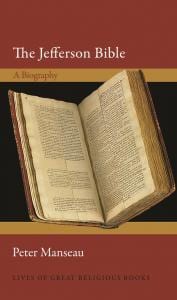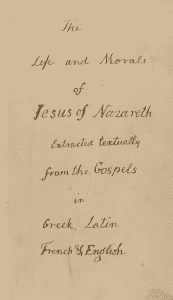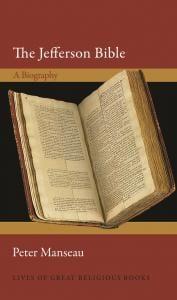SEPTEMBER 10, 2020 BY JOHNTURNER
Peter Manseau is Curator of American Religious History at the Smithsonian. His most recent book is The Jefferson Bible: A Biography, a contribution to Princeton University Press’s Lives of Great Religious Books series. Thanks, Peter, for engaging in this conversation about your book about Jefferson’s Bible project.
What is the Jefferson Bible, and how did Jefferson create it?

The book best known known as the Jefferson Bible is a collage of Gospel verses that Jefferson called “The Life and Morals of Jesus of Nazareth,” which he completed at Monticello in 1820. Jefferson wanted to reduce the New Testament to the core of Christianity and believed he could so by separating the life and teachings of Jesus from elements he considered to be later additions brought about by the misunderstanding of his followers – a task he felt was as easy as separating “diamonds from dunghills.” Using a pen knife and editions of the Gospels in English, French, Greek and Latin, Jefferson clipped around 1000 verses and pasted them together in a bound book, intending to produce a coherent narrative of Jesus’s ministry. As he hoped to reconcile Christian tradition with the evidence-based ideals of the Enlightenment, he had no use for the supernatural, and so the Jefferson Bible lacks such events as the virgin birth, miracles like turning water into wine, and even the resurrection. After Jefferson’s death in 1826, the Life and Morals remained a family keepsake for decades before it was rediscovered by the US National Museum (the Smithsonian) and published soon after.
Multiple mid-nineteenth-century writers suggested that Jefferson used the Life and Morals devotionally, that he read it nightly for solace and instruction. Is there any truth to these reports? Do we know that Jefferson made any ongoing use of the Life and Morals at all?
Jefferson let very few people know he had created his edited volume of scripture, so there is little reason he would have created it except for his own use. Whether his personal use could be described as devotional, I couldn’t say. However, one remarkable the thing the book reveals is just how much Jefferson thought about the nature of the Gospels and the figure of Jesus. It puts the attacks on his religiosity he endured during the election of 1800 in an entirely new light. Some said Jefferson would confiscate Bibles if elected but in fact throughout his entire life he pursued an engagement with scripture that was at once critical and deeply interested in understanding.
In Mere Christianity, C.S. Lewis suggested that based on the New Testament gospels, Jesus was either “the Son of God, or else a madman and something worse.” Lewis found it ridiculous to suggest – as did Jefferson – that Jesus was a great moral teacher. You do not endorse Lewis’s conclusion in your analysis, but you do suggest that Jefferson’s unshackling of Jesus’s ethics from the miraculous elements of the gospels create other problems. Specifically, you contend that in Jefferson’s hands, Jesus comes across “as not particularly Christlike.” What do you mean?
Jefferson was convinced all the astonishing things the New Testament says Jesus did that made him a marvel to some and a threat to others were fictions. Whether or not this is true as a matter of history, Jefferson did not sufficiently account for the fact that the miraculous nature of Jesus’s ministry is integral to the Gospel narratives. They simply do not make sense without it. One example I cite in the book is the curious moment in the Life and Morals when Jesus talks about healing in the presence of someone who needs to be healed, and then suggests he has the ability to do so. In the Gospel account, the narrative build-up is all about putting Jesus in a position where he can show his power, but ultimately in Jefferson’s edit, he does nothing! This stymies the story in a couple ways: First, if no healing takes place, neither the one who might have been healed nor those who might have witnessed it are given something and someone to believe in and talk about. Second, and perhaps more importantly in terms of narrative logic, without such displays of otherworldly power, there is no reason presented for worldly powers to find Jesus sufficiently threatening that he would be crucified. Without Jesus acting like the son of God, the story just falls apart. Certainly there have been literary attempts to tell a fully human story of Jesus that solve this problem, but working only with the text of the Gospels as raw material, Jefferson crafts a Jesus that may be even harder to believe in.
A book’s biography includes not just its inspiration and initial creation, but its reception and interpretation. Why have Americans disagreed so vigorously about the meaning of this book?

It may be because so many who have expressed an opinion about the Life and Morals of Jesus of Nazareth haven’t actually taken the time to read it or the personal letters Jefferson left behind explaining what he did and why. Jefferson’s project was fairly straightforward, and very much of his time in terms of hoping to reconcile Christianity with the Enlightenment, yet people in every generation have contorted themselves to find ways his concerns mirrored their own. This is perhaps inevitable: even calling it “the Jefferson Bible” combines two highly contested symbols; both Jefferson and the Bible separately serve as screens on which we project our understandings of history, faith, America, etc. The two together are just too potent not to do the same.
Jefferson once described himself as a “real Christian.” What did he mean by that statement?
The way he explained this himself was that to be a “real Christian” meant to be “a disciple of the doctrines of Jesus.” Note that he does not say a disciple of Jesus, but rather of his doctrines. For Jefferson, the moral teachings found in the Gospels were what was worthy of study and emulation, rather than a fixation on the man himself, particularly of this fixation amounted to deification. Jefferson also intended his claim to be a “real Christian” as simultaneously a charge that others were not. He felt that Christians of his day, who called him an infidel and worse, were in fact practitioners of a religious system that would have been unrecognizable to Jesus himself.
I love your discussion of Cyrus Adler, who purchased the Life and Morals for the Smithsonian. Adler evidenced a longstanding interest in the broad history of religion and especially in particular American contributions to religion. In your work at the Smithsonian, do you see yourself as continuing in Adler’s vein or departing from it?
When I became the Curator of Religion at the National Museum of American History in 2016 I may have harbored some Indiana Jones fantasies about what my work might entail, but since learning of Cyrus Adler – which I did in my first few days on the job – he has been my role model, and maybe even my patron saint. Beginning in the 1890s he built a collection at the US National Museum that spoke to religion as a subject of both global significance and vital national interest. As importantly, he had strong views that in the US we should not consider religion in terms of majority vs minority traditions, but that each community’s rights and freedoms are the equal of any other, regardless of demographics. Much of my own research and writing, like my 2015 book One Nation Under Gods, has focused on the out-sized and enduring influence of smaller religious traditions in America, so Adler’s approach was right up my alley. Of course, I may be guilty of reading into his legacy echoes of the kinds of work I try to do, just as so many have done with Jefferson and his Bible, but Adler’s success demonstrating the enduring relevance of the history of religion both inside and outside the museum is something to which I continue to aspire.
